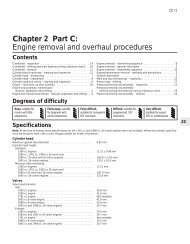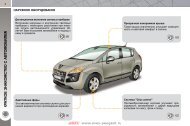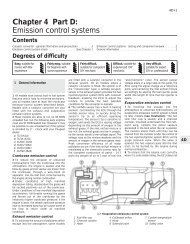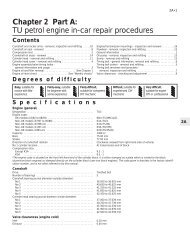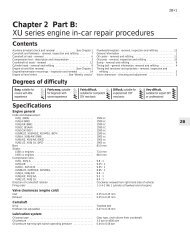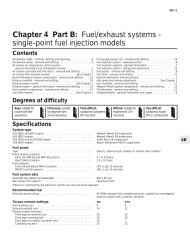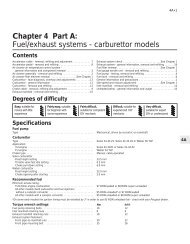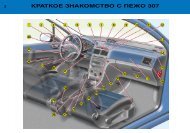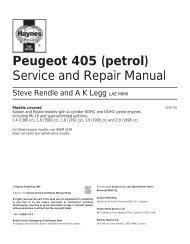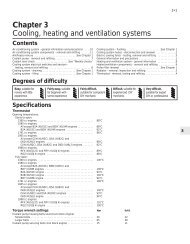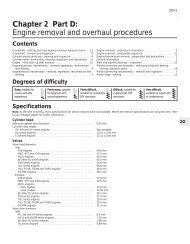Chapter 1 Routine maintenance and servicing
Chapter 1 Routine maintenance and servicing
Chapter 1 Routine maintenance and servicing
You also want an ePaper? Increase the reach of your titles
YUMPU automatically turns print PDFs into web optimized ePapers that Google loves.
36 000 Mile / 3 Year Service 1•23<br />
2 Make sure that all instruments read correctly,<br />
<strong>and</strong> switch on all electrical equipment in turn, to<br />
check that it functions properly.<br />
Steering <strong>and</strong> suspension<br />
3 Check for any abnormalities in the steering,<br />
suspension, h<strong>and</strong>ling or road “feel”.<br />
4 Drive the vehicle, <strong>and</strong> check that there are<br />
no unusual vibrations or noises.<br />
5 Check that the steering feels positive, with<br />
no excessive “sloppiness”, or roughness, <strong>and</strong><br />
check for any suspension noises when<br />
cornering <strong>and</strong> driving over bumps.<br />
Drivetrain<br />
6 Check the performance of the engine, clutch<br />
(where applicable), transmission <strong>and</strong> driveshafts.<br />
7 Listen for any unusual noises from the<br />
engine, clutch <strong>and</strong> transmission.<br />
8 Make sure that the engine runs smoothly<br />
when idling, <strong>and</strong> that there is no hesitation<br />
when accelerating.<br />
9 Check that, where applicable, the clutch<br />
action is smooth <strong>and</strong> progressive, that the<br />
drive is taken up smoothly, <strong>and</strong> that the pedal<br />
travel is not excessive. Also listen for any<br />
noises when the clutch pedal is depressed.<br />
10 On manual transmission models, check<br />
that all gears can be engaged smoothly<br />
without noise, <strong>and</strong> that the gear lever action is<br />
not abnormally vague or “notchy”.<br />
11 On automatic transmission models, make<br />
sure that all gearchanges occur smoothly,<br />
without snatching, <strong>and</strong> without an increase in<br />
engine speed between changes. Check that<br />
all the gear positions can be selected with the<br />
vehicle at rest. If any problems are found, they<br />
should be referred to a Peugeot dealer.<br />
12 Listen for a metallic clicking sound from<br />
the front of the vehicle, as the vehicle is driven<br />
slowly in a circle with the steering on full-lock.<br />
Carry out this check in both directions. If a<br />
clicking noise is heard, this indicates wear in a<br />
driveshaft joint, in which case the complete<br />
driveshaft must be renewed (see <strong>Chapter</strong> 8).<br />
Braking system<br />
13 Make sure that the vehicle does not pull to<br />
one side when braking, <strong>and</strong> that the wheels<br />
do not lock prematurely when braking hard.<br />
14 Check that there is no vibration through<br />
the steering when braking.<br />
15 Check that the h<strong>and</strong>brake operates<br />
correctly, without excessive movement of the<br />
lever, <strong>and</strong> that it holds the vehicle stationary<br />
on a slope.<br />
16 Test the operation of the brake servo unit<br />
as follows. Depress the footbrake four or five<br />
times to exhaust the vacuum, then start the<br />
engine. As the engine starts, there should be a<br />
noticeable “give” in the brake pedal as<br />
vacuum builds up. Allow the engine to run for<br />
at least two minutes, <strong>and</strong> then switch it off. If<br />
the brake pedal is now depressed again, it<br />
should be possible to detect a hiss from the<br />
servo as the pedal is depressed. After about<br />
four or five applications, no further hissing<br />
should be heard, <strong>and</strong> the pedal should feel<br />
considerably harder.<br />
1



